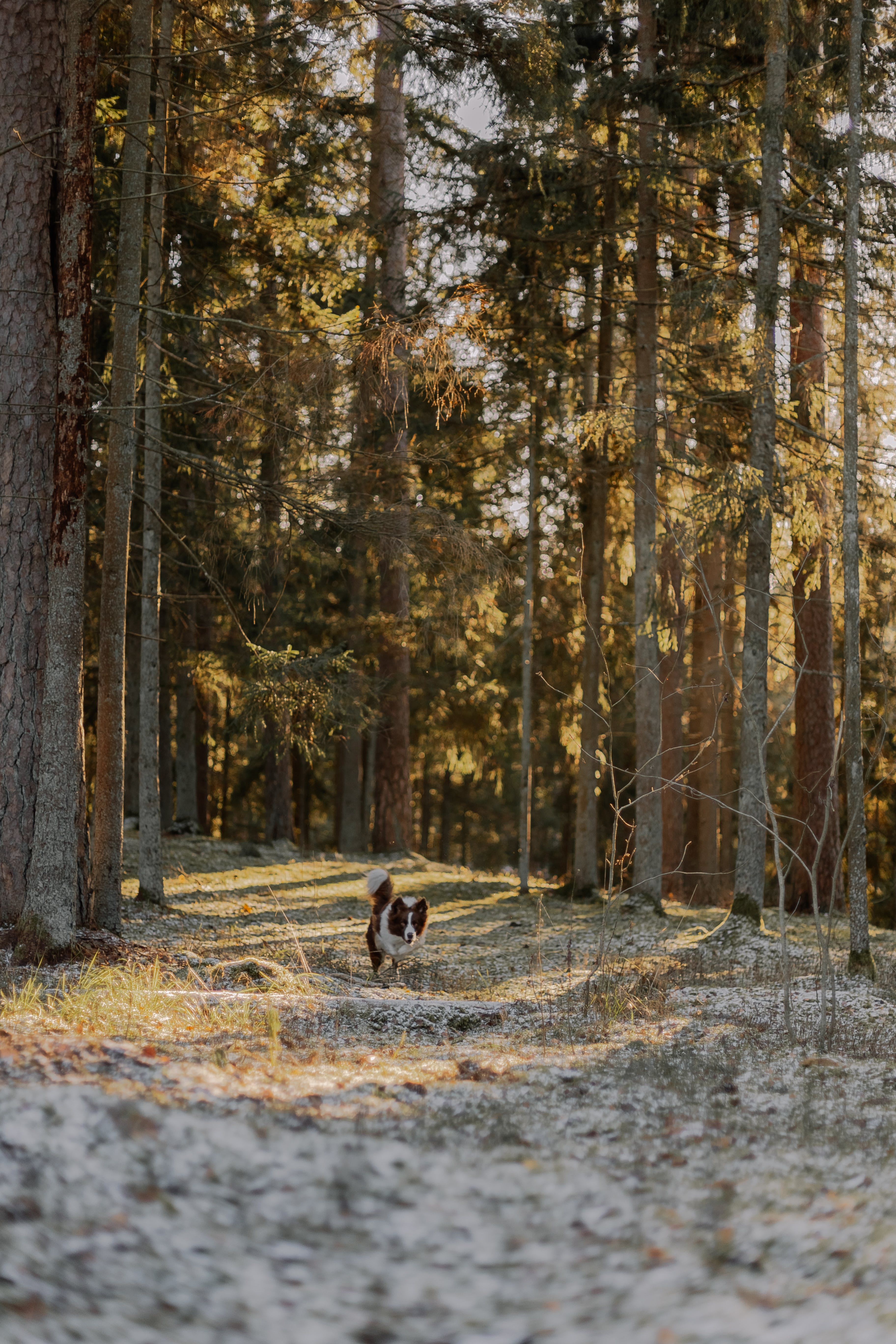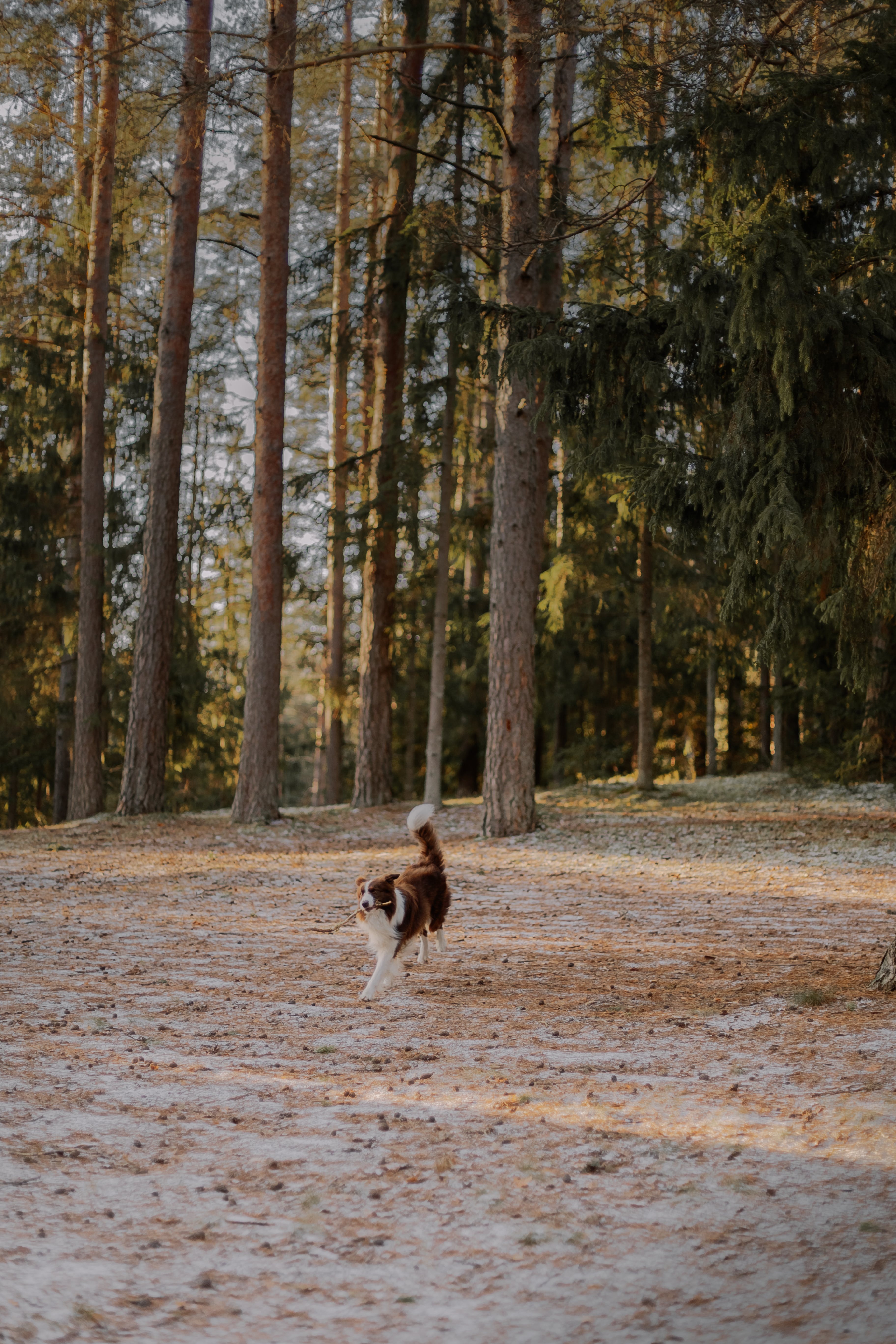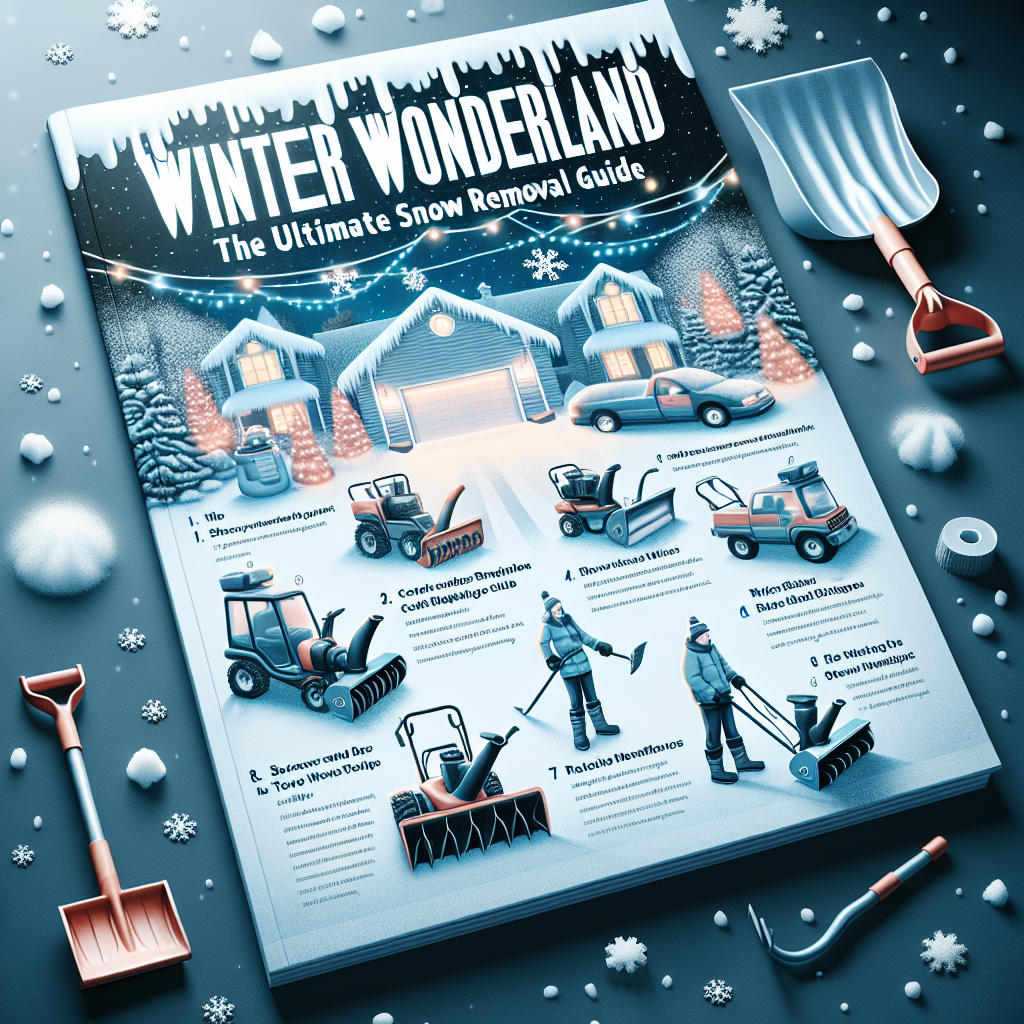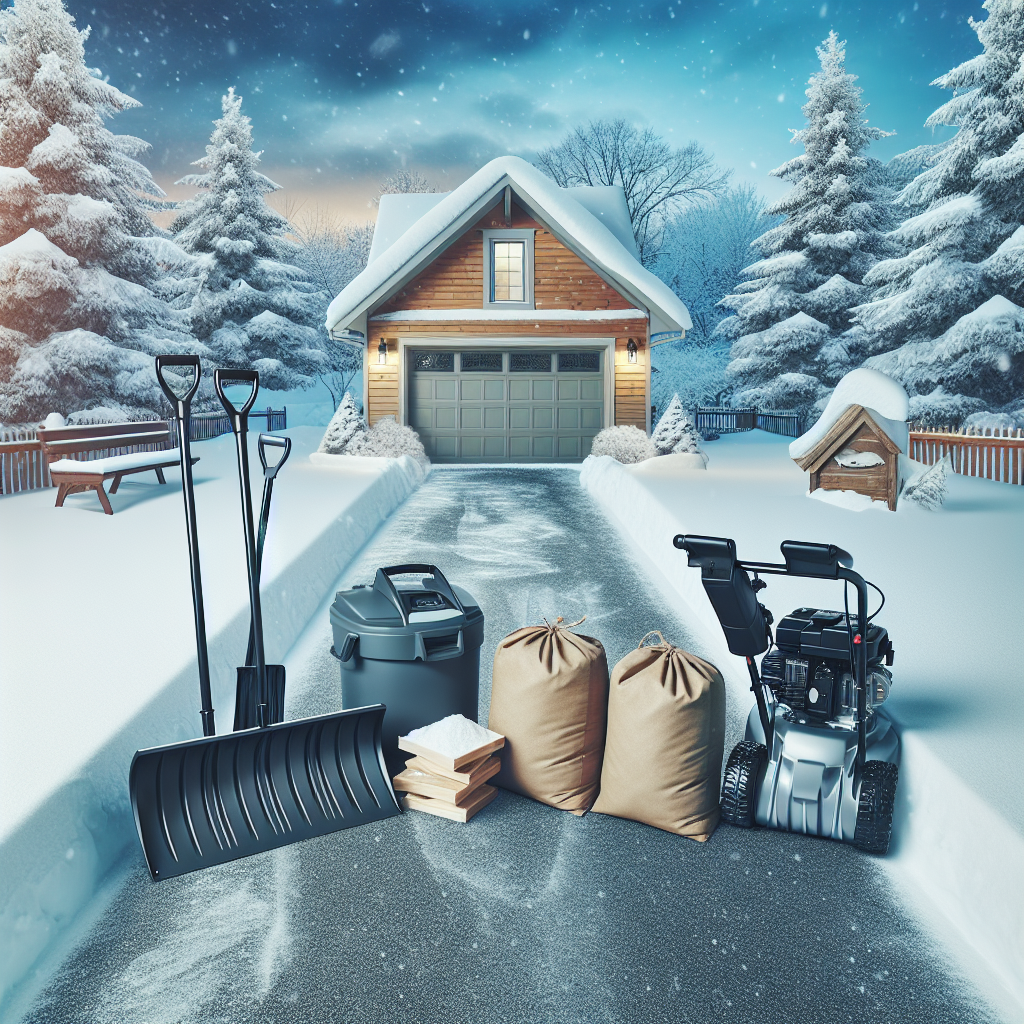Winter Wonderland: The Ultimate Snow Removal Guide is your go-to resource for conquering the challenges of winter weather. From the first delicate flakes to the heavy snowstorms, this comprehensive guide will equip you with practical tips and techniques to efficiently clear your driveways, walkways, and sidewalks, allowing you to navigate through the winter wonderland with ease. Whether you are new to snow removal or a seasoned pro, this article will provide valuable insights on choosing the right tools, preventing ice buildup, and ensuring your safety while tackling the white blanket that winter brings. Say goodbye to snow-induced stress and hello to a hassle-free winter season with our expert advice and friendly tips.

Preparing for Winter
Winter is just around the corner, and it’s time to start preparing for the snowy season ahead. One important aspect of winter preparation is ensuring that you have the right snow removal equipment. By selecting the appropriate tools, inspecting and maintaining them, and stocking up on essential supplies, you can be well-prepared to tackle the snow and keep your property safe and accessible.
Choosing the Right Snow Removal Equipment
When it comes to snow removal, having the right equipment makes all the difference. The first step in selecting the right tools is to assess your needs. Consider the size of your property, the amount of snowfall you typically experience, and your physical capabilities. If you have a small area to clear, a simple snow shovel may be sufficient. For larger areas or heavy snowfall, a snow blower or even a snow plow attachment for your vehicle may be necessary.
Inspecting and Maintaining Your Equipment
Before the first snowfall hits, it’s crucial to inspect your snow removal equipment and ensure that everything is in proper working order. Check for any damage, such as bent blades on shovels or worn belts on snow blowers. Make sure all moving parts are well-lubricated, and replace any worn or broken parts. Regular maintenance throughout the winter season will help to keep your equipment functioning efficiently and prolong its lifespan.
Stocking up on Essential Supplies
In addition to having the right snow removal equipment, it’s important to stock up on essential supplies. Keep a sufficient supply of ice melt or rock salt to effectively melt ice and prevent slippery surfaces. It’s also a good idea to have extra fuel for your snow blower or any other equipment that requires it. Additionally, make sure you have a supply of sturdy gloves, warm clothing, and non-slip footwear to keep you safe and comfortable while working in the cold.
Snow Removal Techniques
With the right equipment in hand, it’s time to learn about various snow removal techniques. Different situations call for different approaches, so it’s essential to familiarize yourself with the most effective methods for clearing snow.
Shoveling
Shoveling is a classic snow removal technique that can be effective for smaller areas. When shoveling, it’s important to use proper body mechanics to avoid strain or injury. Lift with your legs, not your back, and take breaks as needed. Clear snow from the top down, starting with a path in the middle and then working your way outwards.
Snow Blowing
Snow blowers are a popular option for removing snow from larger areas. These machines use an auger to scoop up the snow and then blow it out through a chute. To use a snow blower effectively, start in the middle of the area you want to clear and work your way outwards in a systematic pattern. Be mindful of the direction of the wind to avoid blowing snow back onto areas you’ve already cleared.
Using a Snow Plow
For clearing large areas, such as driveways or parking lots, using a snow plow can be efficient and time-saving. Whether you have a plow attachment for your vehicle or a standalone snow plow, it’s essential to learn the proper techniques for effective snow removal. Start by pushing the snow into windrows, then push those windrows off to the sides. Take care to avoid damaging the pavement or any obstacles in the area.
Applying De-icing Products
After clearing away the bulk of the snow, it’s important to apply de-icing products to prevent the formation of ice and keep surfaces safe. Rock salt or ice melt can be spread evenly over the cleared area, paying extra attention to high-traffic areas and any potential hazards. Follow the product instructions for the recommended application rates, and be mindful of environmental considerations, such as the potential damage to plants or concrete surfaces.

Safety Tips
Snow removal can be physically demanding and potentially dangerous, so it’s essential to prioritize safety. By following these safety tips, you can minimize the risk of accidents or injuries while removing snow.
Dressing for Cold Weather
When working in the cold, dressing appropriately is crucial. Layer your clothing to trap warmth and choose materials that wick away moisture. Wear a warm hat, gloves or mittens, and waterproof boots with good traction. Don’t forget to protect your face and neck with a scarf or face mask. It’s also important to stay hydrated and take breaks in a warm area to avoid frostbite or hypothermia.
Warm-Up Exercises
Before tackling the task of snow removal, it’s important to warm up your muscles and increase flexibility. Engage in light exercises or stretches to get your blood flowing and prepare your body for physical activity. Focus on warming up your back, shoulders, and legs, as these areas are commonly used during snow removal.
Proper Lifting Techniques
When shoveling or lifting heavy loads of snow, it’s crucial to use proper lifting techniques to avoid strain or injury. Bend your knees and lift with your legs, not your back. Keep your back straight and avoid twisting or jerking movements. If the load is too heavy, ask for assistance or use equipment, such as a snow blower or snow plow, to minimize the need for heavy lifting.
Avoiding Overexertion
Snow removal can be physically demanding, so it’s important to avoid overexerting yourself. Pace yourself and take regular breaks to rest and hydrate. Listen to your body and stop immediately if you experience any pain, shortness of breath, or dizziness. If you have any underlying health conditions or concerns, consult with your healthcare provider before engaging in strenuous physical activity.
Preventing Slips and Falls
Snow and ice can create slippery surfaces, increasing the risk of slips and falls. Take measures to prevent these accidents by wearing footwear with good traction and using ice melt or salt to minimize ice formation. Take small steps and walk slowly, keeping your center of gravity over your feet. Be mindful of any uneven surfaces or hidden obstacles, such as hidden ice patches or uneven pavement.
Snow Removal Strategies for Different Areas
Different areas require different approaches when it comes to snow removal. Whether you’re tackling driveways and walkways, stairs and steps, roofs and gutters, sidewalks and public spaces, or parking lots and commercial areas, here are some strategies to consider.
Driveways and Walkways
When clearing driveways and walkways, start by removing any loose snow with a shovel or snow blower. Then, apply de-icing products to prevent ice formation. Be sure to shovel or blow snow to the sides, creating a clear and safe path for vehicles and pedestrians.
Stairs and Steps
For stairs and steps, it’s important to remove snow and ice promptly to prevent accidents. Use a shovel or broom to clear away snow, and then apply ice melt or salt to minimize the risk of slippery surfaces. Pay special attention to handrails, ensuring they are clear of snow and ice for added safety.
Roofs and Gutters
Clearing snow from roofs and gutters is crucial to prevent ice dams and structural damage. Use a roof rake or snow blower to remove snow from the roof, starting from the edge and working your way up. Clear gutters of any snow or ice buildup to ensure proper drainage and prevent water damage.
Sidewalks and Public Spaces
When it comes to sidewalks and public spaces, it’s important to clear them promptly and thoroughly to ensure the safety of pedestrians. Use a combination of shoveling, snow blowing, and de-icing products to keep these areas clear and easily accessible.
Parking Lots and Commercial Areas
For larger areas such as parking lots and commercial areas, snow plows and specialized equipment may be necessary. Clear snow in a systematic manner, pushing it into windrows and then off to the sides. Apply de-icing products to prevent ice formation and ensure the safety of vehicles and pedestrians.

Environmentally Friendly Snow Removal
While snow removal is necessary for safety and accessibility, it’s important to consider the environmental impact of these practices. By adopting environmentally friendly snow removal techniques, you can minimize the negative effects on the ecosystem.
Using Eco-Friendly De-icing Agents
Traditional de-icing agents, such as rock salt, can have detrimental effects on plants, soil, and water bodies. Consider using eco-friendly alternatives, such as calcium magnesium acetate (CMA) or potassium acetate, which are less harmful to the environment. These de-icing agents are effective in preventing ice formation while reducing the environmental impact.
Minimizing Salt Usage
Excessive salt usage can lead to water contamination and damage to vegetation. Use salt sparingly and strategically, focusing on high-traffic areas and problem spots. Consider other methods, such as snow plowing or mechanical removal, to reduce the need for salt altogether.
Implementing Snow Melting Systems
Snow melting systems, such as heated driveways or sidewalks, can be an effective and environmentally friendly alternative to traditional snow removal methods. These systems use radiant heat to melt snow and prevent ice formation, eliminating the need for shoveling, snow blowing, or the use of de-icing products.
Removing Snow from Vehicles
In addition to clearing snow from your property, it’s important to remove snow from your vehicles to ensure safe driving conditions and prevent damage.
Clearing Snow off Cars
When removing snow from cars, start by using a snow brush or broom to clear snow from the roof, hood, and trunk. Then, use an ice scraper to remove any ice or snow from the windows and mirrors. Be thorough to improve visibility and prevent snow or ice from flying off while driving.
Removing Snow from Trucks and SUVs
Clearing snow from trucks and SUVs may require additional effort due to their larger size. Use a long-handle brush or broom to reach the top of the vehicle and ensure that all snow is removed. Pay extra attention to side mirrors, headlights, and taillights, ensuring they are clear and visible.
Preventing Ice Build-Up on Windshields
To prevent ice build-up on windshields, consider using a windshield cover or tarp during snowy weather. Alternatively, apply a de-icing agent, such as a commercial ice repellent spray, to the windshield prior to snowfall. This will help to prevent ice formation and make snow and ice removal easier.

Winter Weather Forecasting
Understanding weather predictions and monitoring storm systems can help you prepare for upcoming snowfall and plan your snow removal efforts.
Understanding Weather Predictions
Stay informed about weather predictions by checking local forecasts and staying updated on winter storm warnings or advisories. Familiarize yourself with the terminology used in weather forecasts, such as snow accumulation estimates, wind chill factors, and the timing of the storm.
Monitoring Storm Systems
As a snow removal enthusiast, it’s essential to monitor storm systems to anticipate the amount and duration of snowfall. Utilize weather tracking tools and apps to stay informed about the storm’s path, intensity, and timing. This information can help you plan your snow removal efforts and ensure that you’re well-prepared for the impending snowfall.
Preparing in Advance
Based on weather predictions and storm monitoring, it’s crucial to prepare in advance for the upcoming snowfall. Stock up on essential supplies, ensure that your snow removal equipment is in good working condition, and clear any potential obstacles or hazards from your property. By being proactive and prepared, you can minimize the impact of winter storms and ensure a smoother snow removal process.
Snow Removal Services
In some cases, hiring professional snow removal services may be the best solution for efficient and effective snow removal. Consider the following factors when choosing a snow clearing company and negotiating contracts.
Hiring Professional Snow Removal Services
Professional snow removal services can save you time and effort, especially for large properties or areas with heavy snowfall. Research local snow removal companies, read reviews, and ask for recommendations from friends and neighbors. Look for companies with experience, a good reputation, and the necessary equipment to handle your specific needs.
Choosing the Right Snow Clearing Company
When selecting a snow clearing company, consider factors such as reliability, availability, and response time. Ensure that the company has the resources and personnel to handle your property’s size and snow removal requirements. Request a detailed estimate and ask about the company’s insurance coverage and liability policies.
Negotiating Contracts
Before signing a contract with a snow clearing company, thoroughly review the terms and conditions. Ensure that the contract specifies the scope of work, frequency of service, and pricing details. Clarify any additional charges or contingencies for severe weather conditions. Discuss the contract length and renewal options to ensure a mutually beneficial agreement.

Winter Sports and Recreation
Snowy conditions provide opportunities for winter sports and recreation. If you’re a ski enthusiast or enjoy other winter activities, here are some tips for creating safe paths and maintaining winter recreation spaces.
Creating Safe Paths for Skiing and Snowboarding
If you have a ski resort, maintaining safe paths for skiing and snowboarding is crucial for the enjoyment and safety of your guests. Regularly groom the slopes, removing any obstacles or hazards. Ensure that snowmaking operations are well-managed to provide optimal skiing conditions. Monitor weather conditions and follow safety protocols to prevent accidents and injuries.
Maintaining Ice Rinks
For those who enjoy ice skating or hockey, maintaining ice rinks is essential. Regularly resurface the ice to provide a smooth and even surface for skating. Clear snow from the ice and surrounding areas to prevent hazards. Maintain proper lighting and signage to ensure visibility and safety.
Clearing Snow for Winter Events
Winter events, such as festivals or outdoor concerts, often require snow removal to create accessible and safe spaces. Plan ahead and coordinate with event organizers to determine the necessary snow removal schedule and techniques. Ensure that paths, seating areas, and emergency exits are clear of snow, allowing for a memorable and safe winter event.
Emergency Snow Removal
During severe snowstorms or emergencies, it becomes even more crucial to prioritize snow removal. Clearing snow from entrances and exits, ensuring access to emergency services, and managing snow removal during power outages are all essential aspects of emergency snow removal.
Clearing Snow from Entrances and Exits
During severe snowstorms, it’s important to clear snow from entrances and exits to ensure access to buildings. Clear paths to doors, ramps, and emergency exits, allowing for safe and unobstructed entry and exit. Pay special attention to areas used by emergency services, such as fire hydrants or ambulance bays, ensuring that they are clear and easily accessible.
Ensuring Access to Emergency Services
In times of emergency, it’s crucial to ensure that emergency services have unobstructed access to your property. Clear snow from fire hydrants, fire lanes, and access roads, enabling emergency vehicles to reach their destination quickly and safely. Be proactive in coordinating with local emergency services to ensure that they are aware of your snow removal efforts and any restrictions or requirements.
Snow Removal During Power Outages
Snow removal becomes even more challenging during power outages. In such situations, prioritize clearing paths to generators, utility access points, and backup power sources. Ensure that essential equipment, such as snow blowers or shovels, is readily available and that you have a plan in place to manage snow removal without relying on electrical power.
Winter Wonderland: The Ultimate Snow Removal Guide
With winter just around the corner, it’s time to prepare for the snowy season ahead. By choosing the right snow removal equipment, employing various snow removal techniques, prioritizing safety, and considering environmental factors, you can navigate the winter wonderland with ease. Whether you tackle snow removal on your own, hire professionals, or engage in winter sports and recreation, this comprehensive guide will help you navigate the challenges and make the most of the snowy season. Stay warm, stay safe, and enjoy the beauty of winter while ensuring safety and accessibility for yourself and others.

